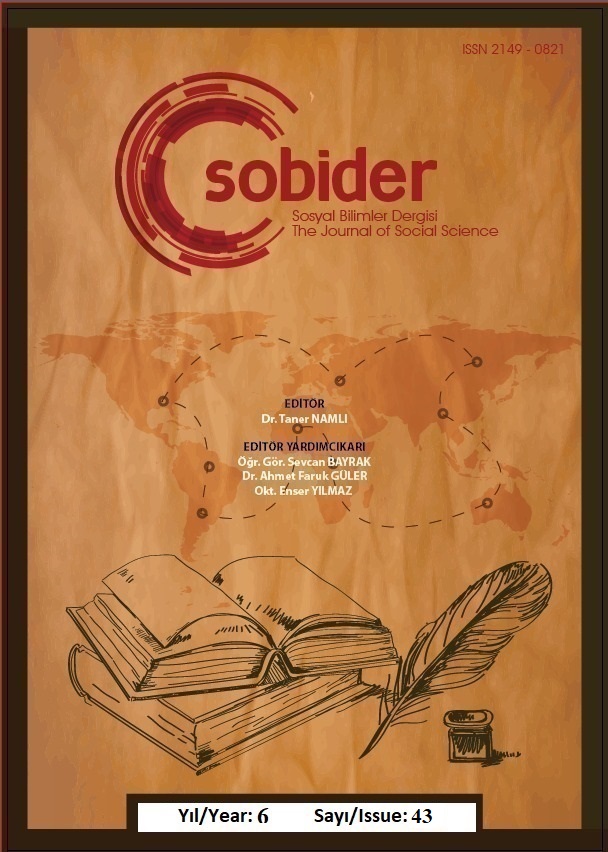Author :
Abstract
Tasavvuf öğretisinde Allah, bilinmek ve sevilmek muradıyla varlığı yaratmıştır. Yaratılmışlar içerisinde onu hakkıyla bilecek ve sevecek tek varlık ise insandır. Hak onun fani bedenine kendi ruhundan üfleyerek onu ebediyen diri kılmıştır. Onun celal ve cemal sıfatlarını kendinde toplayan insan, ondan, aslî vatanından ayrı düşerek dünyaya indirilmiştir. İnsanın o andan sonraki çabası, ayrı düştüğü vatanına ve bütününe kavuşmak, yaratılış halkasını tamamlayarak insan-ı kâmil makamına ulaşmaktır. Allah, insanı yeryüzüne indirdikten sonra onu başıboş bırakmamış, onlara Peygamberler göndermiştir. Son Peygamber Hz. Muhammed’den sonra ise onlara rehber olacak, yolunu aydınlatacak Hak âşıkları göndermiş ve Hak, Peygamber varisi olan bu âşıkları, arifleri Peygamberlerin kalbine vahyettiği ilm-i ilahinin sırlarına vakıf kılmıştır. Dolayısıyla tasavvuf bâtın ilmidir ve şiirsel dilde izhar olması mümkün olmadığından birtakım semboller kullanılmış, akla halel getirecek benzetmeler yapılmıştır. Fehîm-i Kadîm de tasavvufun bâtıni boyutunu Sebk-i Hindî’nin girift yapısıyla sentezleyip şiirsel bir anlatım içinde gazellerinde işleyerek hem ariflerin/âşıkların özelliklerini hem de duyumsadıkları o tarifi imkânsız kesif duyguları aktarmaya çalışmıştır.
Keywords
Abstract
In the doctrine of Sufism, God created existence to be known and loved. The only creature among the created things that knows and loves it is the human being. God has blown her/his mortal body from its own soul and made her/his alive forever. The person who collects the attributes of his Celal and Cemal in himself has been sent down to the world by falling apart from his native land. The next effort of the human being is to reach the homeland and the whole and to reach the “insan-ı kamil (perfect human)” maqam by completing the ring of creation After Allah sent man down to earth, he did not abandon him, he sent prophets to them. After the last Prophet Muhammad, Allah sent them lovers of Hak who guides them and illuminates their paths and Hak made these lovers, who are the heirs of the Prophet, know the secrets of the knowledge of the divine whom the revelers revealed to the heart of the prophets. Therefore, Sufism is the science of the batinite, and since it is not possible to have a poetic language, some symbols have been used and analogies have been made that would prejudice the mind. Fehîm-i Kadîm tried to convey both the characteristics of the narrators / minstrels and the unexplained intense feelings that they felt by synthesizing the batinite dimension of Sufism with the intricate structure of Sebk-i Hindî and processing it in ghazals in a poetic expression.
Keywords
- Affifi, Ebu’l-Âla (1999), Muhyiddin İbnû’l Arabi’de Tasavvuf Felsefesi, çev. Mehmet Dağ, Kırkambar Yayınları, İstanbul.
- Arabî, İbn (2011), Nurlar Risalesi, çev. Mahmut Kanık, İnsan Yayınları, İstanbul.
- Arabî, İbn (2012), İlâhi Aşk, çev. Mahmut Kanık, İnsan Yayınları, İstanbul.
- Balyânî, Abdullah B. Mes’ud (2003), Mutlak Birlik, çev. Ali Vasfı Kurt, İnsan Yayınları, İstanbul.
- Chıttıck, Wıllıam C. (1997), Kozmos’taki Tek Hakikat, çev. Ömer Çolakoğlu, Kültür Bakanlığı Yayıncılık, İstanbul.
- Chıttıck, Wıllıam C. (1997), Varolmanın Boyutları, çev. Turan Koç, İnsan Yayınları, İstanbul.
- Demirel, Şener (2006), 17.yy. Sebk-i Hindî Şairlerinden Nailî ve Fehîm’in Şiirlerinde Soyutlama ya da Alışılmamış Bağdaştırmalar, Turkuaz Yayınları, İstanbul.
- Kur’an-ı Kerim ve Açıklamalı Meali (1993), Türkiye Diyanet Vakfı Yayınları, Ankara.
- Kuzu, Fettah (2013), Şeyh Gâlip Divanı’nda “Hak, Varlık ve İnsan”, (Basılmamış Doktora Tezi), Fırat Üniversitesi Sosyal Bilimler Enstitüsü, Elazığ.
- Küçük, Sabahattin (1984) Fehîm-i Kadîm Başka Bir Mahlas ile Şiir Söyledi mi? Kaynaklar Dergisi, Ankara.
- Pürcevâdi, Nasrullah (1998), Can Esintisi, İslam’da Şiir Metafiziği, çev. Hicabi Kırlangıç, İnsan Yayınları, İstanbul.
- Schuon, Frıthjoh (1996), İslâm’ın Metafizik Boyutları, çev. Mahmut Kanık, İz Yayıncılık,
- Schimmel, Annemarie (2004), Tanrı’nın Yeryüzündeki İşaretleri, çev. Ekrem Demirli, Kabalcı Yayınevi, İstanbul.
- Üzgör, Tahir (1991), Fehîm-i Kadîm, Hayatı, Sanatı, Divan’ı ve Metnin Bugünkü Türkçesi, AKM Yayınları, Ankara.
- Yıldırım, Ali (2007), Siyah Bahar Tamlamasının Bir Üslûp Özelliği Olarak Divan Şiirinde Yer Alması, İlmi Araştırmalar Dil ve Edebiyat İncelemeleri, S.23, Bahar.





